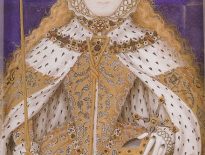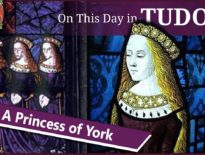On this day in Tudor history, 16th November 1601, nobleman and rebel Charles Neville, 6th Earl of Westmorland, died while in exile at Nieuwpoort in Flanders.
Westmorland had fled into exile following the failure of the Northern Rebellion, a plot to release Mary, Queen of Scots, from prison and to overthrow Elizabeth I. He didn't learn his lesson, being involved in a further plot.
The earl died a sad end in debt and separated from his wife and daughters, but it was his own fault.
Find out more about the rebel northern earl in today's talk.
Also on this day in history, 16th November 1612, Elizabethan conspirator, William Stafford, died. He's an interesting Tudor character because he had Plantagenet blood and also because he was allegedly the chief plotter in the Stafford Plot, a plot to assassinate Queen Elizabeth I, but he was only imprisoned for a short time and lived the rest of his life quietly in Norfolk, dying a natural death.
How and why did William Stafford escape serious punishment for the Stafford Plot and what did Sir Francis Walsingham have to do with it all? Find out in last year’s video:
Here's the video on the Northern Rebellion in case you missed it:
Also on this day in history:
- 1531 – Death of John Batmanson, prior of the London Charterhouse, at the Charterhouse. He was buried in the cemetery there. Batmanson is said to have written treatises against the works of Martin Luther and Jacques Lefèvre d'Étaples, and he also criticised Erasmus.
- 1585 – Death of Gerald Fitzgerald, 11th Earl of Kildare and an Irish peer, in London. His body was taken to Kildare and buried there in February 1586. Fitzgerald was created Earl of Kildare and Baron of Offaly after helping put down Wyatt's Rebellion in 1554. He was imprisoned in the Tower of London twice for treason (1575 and 1582), but was cleared both times.
- 1596 – Death of Sir Francis Willoughby, industrialist and coalowner, in London. He was buried at St Giles Cripplegate. Willoughby is known for building Wollaton Hall in Nottinghamshire, developing coal mines on the estate, growing and processing woad there and in Ireland, and establishing two blast furnaces, for iron, at Middleton and Oakamoor, in Staffordshire, and buying one at Codnor in Derbyshire.
Transcript:
On this day in Tudor history, 16th November 1601, nobleman and rebel Charles Neville, 6th Earl of Westmorland, died while in exile at Nieuwpoort in Flanders.
With the Percy family, the Nevilles had led the Northern Rebellion, a plot to release Mary, Queen of Scots, from prison and to overthrow Elizabeth I. When the plot failed, Neville fled to Scotland and then on to Flanders.
But his plotting didn’t stop there. Let me tell you a bit more about Westmorland…
• Charles Neville was born in 1542 or 1543 and was the only surviving son of Henry Neville, 5th Earl of Westmorland, and Anne Manners.
• He spent his childhood at the family seat of Raby Castle in County Durham, where he was brought up as a Catholic.
• Charles was style Baron Neville between 1549 and 1563, and became Earl of Westmorland on his father’s death in 1564.
• His father was a staunch supporter of the Catholic Queen Mary I, and on 19th July 1553, Charles, who was only around ten years old at the time, signed a letter proclaiming Mary as queen in place of the Protestant Lady Jane Grey.
• In around 1563/4, Charles married Jane Howard, daughter of the late Henry Howard, Earl of Surrey, and sister of Thomas Howard, 4th Duke of Norfolk. Charles and Jane had four daughters and a son who died in infancy.
• Charles was heavily involved in the November 1569 Northern Rebellion against Elizabeth I, supported by his wife, whose brother the Duke of Norfolk was to marry Mary, Queen of Scots if the rebellion was successful. I’ll give you a link to my video on the rebellion, but suffice to say that it failed. Charles was proclaimed a traitor on 26th November 1569, but he and his co-rebel Thomas Percy, 7th Earl of Northumberland, had fled to Scotland.
• In Scotland, Charles was protected by Sir Thomas Ker, laird of Ferniehirst in Roxburghshire, and in 1570 was able to flee into exile in the Spanish Netherlands. He would never see his wife or daughters again.
The unfortunate Northumberland was handed over to Elizabeth I and executed in 1572.
• His cousin, spy Sir Robert Constable, who was working for Sir Ralph Sadler, tried to persuade Charles to return to England for a pardon, but Charles wasn’t fooled. Attempts to kidnap him in 1575 and 1586 also failed.
• While he was in exile, he became friends with military leader Don John of Austria and served as a colonel in the Spanish army.
• In 1571, just a year after he’d fled into exile, Charles became involved in the Ridolfi Plot which again sought to depose Elizabeth I in favour of Mary, Queen of Scots. Charles did his part by trying to get Philip of Spain’s support. The plot failed.
• In 1581, he went on a pilgrimage to Rome and in 1583 he served as a captain under the Duke of Parma. He also served under Parma during the Spanish Armada in 1588.
• In 1593, his wife, Jane, died, and there were negotiations for him to marry a daughter of Jean Grusset Richardot, President of the Council of Artois. Charles died before things were arranged.
• His small pension from Philip of Spain was not enough to support his lifestyle, which has been described as “loose living”, and he died in debt on this day in 1601.



Leave a Reply